
He was elected an Associate at the minimum age of 24, and an Academician five years later in 1831. At the age of just 13, in 1815, he exhibited works there as an “Honorary Exhibitor”. Landseer's life was entwined with the Royal Academy. He studied under several artists, including his father, and the history painter Benjamin Robert Haydon, who encouraged the young Landseer to perform dissections in order to fully understand animal musculature and skeletal structure.

He was something of a prodigy whose artistic talents were recognised early on. Essex's collection also included a picture by Landseer, The Cat's Paw (c.1824 Minneapolis Musuem of Art, Minneapolis) and it seems likely that he purchased the present picture.Landseer was born in London, the son of the engraver John Landseer A.R.A. George, 5th Earl of Essex (1757-1839), was an important early patron of Joseph Mallord William Turner (1775-1851), who painted a number of watercolours for him of his two houses, Hampton Court in Herefordshire and Cassiobury Park, near Watford and Hertfordshire, and also sold him Walton Bridge (National Gallery of Victoria, Melbourne), Purfleet and the Essex Shore (private collection) and Trout Fishing in the Dee (The Taft Musuem, Cincinnati). Landseer portrays hawking as part of a more noble way of life for example Lord Richard Cavendish and his Dog, Spot ( circa 1827, private collection) and Return from Hawking ( circa 1835-37, private collection), the composition of which is dominated by the figure of the humble falcon trainer rather than the fine courtly figures of Lord Egerton and his family.īy the time of its exhibition at the Royal Academy in 1874, this picture was in the collection of Catherine, Countess of Essex, wife of the late Earl of Essex.
Edwin henry landseer code#
References to hawking abound in Scott's novels and Landseer's historical subjects, such as Bolton Abbey in the Olden Time ( circa 1824, The Devonshire Collection, Chatsworth) and Interior of a Castle Courtyard ( circa 1834, Sunderland Museum and Art Gallery), evoking the romantic vision of the old way of life and the chivalric code that way of life entailed. In the early nineteenth century, hawking enjoyed a resurgence of popularity among aristocratic sportsmen. The sport of hawking was associated with the chivalric life of knights in the middle-ages. Here, the falconer with a falcon on his wrist, and a young boy holding a pair of deerhounds, watch as a bird soars high above. The present picture is set against a similar landscape, again with a dramatically stormy sky and low horizon.
.jpg)
1), the foreground of which is dominated by a peregrine hawk bringing down a heron against a stormy sky, the landscape of which recalls his highland subjects. Hawking was a theme which Landseer made the focal point of a number of pictures in the 1830s, most dramatically in Hawking (in the Olden Time), Kenwood, circa 1832 fig. Landseer's iconic masterpiece Monarch of the Glen (1851 Diageo, on loan to the National Museums of Scotland), was painted at the height of his reputation and he continued painting significant highland pictures into the early 1860s. Numerous other sporting pictures set in the highlands followed, often with a narrative or historic interest (for example, The Hunting of Chevy Chase 1825-26, Birmingham Musuems and Art Gallery). Landseer first visited Scotland in 1824 and stayed on the estate of the Duke of Atholl (1755-1830) for whom he was to encapsulate a day's sport in the highlands with his picture The Death of the Stag in Glen Tiltt (1824-30 The Blair Charitable Trust, Blair Castle). By the 1820s, the cult of the highlands had expanded to include a fascination with highland sport and many of the British elite sought to rent or buy stretches of moorland and hill themselves.
.jpg)
The romantic perception of the highlands went back to James Macpherson's publication in 1760-63 of the poems of Ossian and had been enhanced by Sir Walter Scott's depiction of the sublime landscape of the highlands peopled by ghillies, clansmen and peasants, in Rob Roy and The Lady of the Lake. Part of his popularity derived from the success of his highland subjects.

By this time, he had established an influential network of, predominantly aristocratic, patrons, which led to his work finding favour with the young Princess Victoria, who commissioned numerous portraits of her family, pets and other animals, following her accession to the throne in 1837.
Edwin henry landseer full#
By the time that Landseer painted this picture, circa 1835, he had already established a reputation for himself as one of the most precocious and talented artists of his generation, and had demonstrated in his work, the qualities which were to make him the most celebrated animal painter of the nineteenth century.Ī child prodigy, Landseer was elected an associate of the Royal Academy at the youthful age of twenty-four and a full Academician only five years later in 1831.


 0 kommentar(er)
0 kommentar(er)
